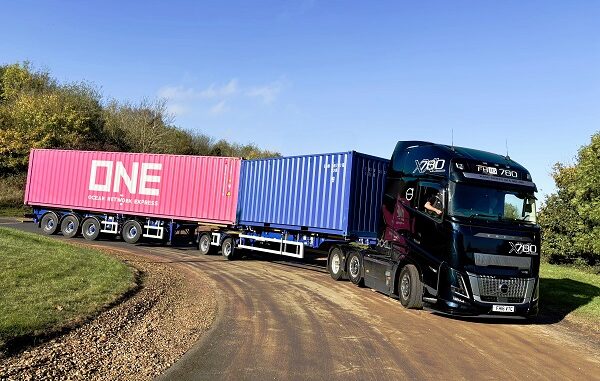
In the January 2025 issue of Transport News, Dan Gilkes looked at Dennison’s proposal for longer heavier vehicles.
Dennison Trailers is looking for UK hauliers keen to maximise their trailer capacity, by pushing for the use of its Link double trailer design.
Available as a box, curtainsider, fridge or skeletal container trailer, the Link system uses a conventional tractor unit with a two-axle sliding chassis trailer, along with a second three-axle trailer. The total combination is 25.25m long and the potential internal volume of two box trailers would be up to 162m3.
By using this double trailer combination, Dennison believes that it would be possible to save one journey in every three, reducing congestion on the roads and cutting emissions. The trailers are already in use throughout Scandinavia, where maximum weights as high as 60-tonnes are permitted.
They are also being used in Germany at 40-tonnes and in Ireland at 44-tonnes GVW. In both cases, the trucks are hauling on major routes between out-of-town depots, with goods transferred to smaller vehicles for urban distribution.
In Ireland, hauliers have to have abide by the Garda Permit System, to use national routes like motorways. The tractor and the trailers have to be nominated on the permit. Once off the national routes, hauliers have to seek a permit from local authorities for further travel.
To meet the regulations in Germany, the rear wheels of the first trailer have to be able to steer, using electric steering as it is a skeletal chassis, to meet tighter turning circle demands. The trailers are able to run in Ireland and in Scandinavia without steering axles.
“We need to get a few good operators behind the idea,” said managing director James Dennison. “It ticks all the boxes. Less trucks on the road and less emissions.”
The company has built more than 1,000 of the combinations since the design first arrived in 2008, with more than 100 running on German roads. Now Dennison is working to get the backing of organisations such as the Road Haulage Association and Logistics UK, to push the concept in the UK.
As the first trailer is a skeletal design, it can be shortened to just 7,720mm and used as an urban trailer if required. Once extended, the trailer is 10,669mm overall, which allows for a 20ft container sitting in front of the rear bogie. A second fifth wheel sits behind, over the two-axle bogie, connecting the 13,515mm second trailer.
While the combination looks like it would be at home tackling the long straight highways of Australia or the USA, Dennison chose UTAC’s Millbrook Proving Ground in Bedfordshire to demonstrate the concept to UK companies.
Admittedly the high-speed bowl at the centre of the facility makes it easy to pilot the combination, which was hooked up to the latest Volvo FH16 tractor. However, Dennison also offered the opportunity to take the Link truck and trailers around the first two sections of Millbrook’s Alpine route.
Designed to test the steering and suspension of cars and vans, the Alpine route has every kind of corner and camber, making it hard work for a regular articulated truck.
Yet, even without steering axles on the first trailer, the combination tracked through the worst that Millbrook could throw at it, without an inside wheel ever clipping a kerb.
Indeed, it required very little extra input from the driver to swing the two trailers through the curves and after a few minutes the additional length was soon far less of a problem than expected.
Having additional load volume leads, inevitably, to a discussion about weight. If you are taking a truck off the road each time the Link combination runs, will operators want to add to the operating weight of the truck?
At present, most of the users in Ireland are in the parcel delivery and logistics business, where load volume is more critical than payload. However, to maximise the appeal of a longer truck and trailer, there are many that would need to justify the move with additional carrying capacity.
“We’re lobbying for 60-tonnes,” said James Dennison.
Whether we will see further development in the UK, will depend on a number of factors, including demand from operators. Certainly, the solutions are available, if anyone wants to help to push the concept with the authorities.
Three years ago, in the shadow of Stoke City’s football ground (TN September 2021), TIP Group hosted a ‘mini expo’, at which Dennison unveiled its Link Trailer, writes Peter Brown.
At the event Stuart Wardlaw, owner of Logistics Fleet Management Support, championed its potential. “It is designed to create awareness and start the campaign for longer truck combinations on UK roads,” he said at the time. “We’d happily run trials of it off-road if it gave us the opportunity to demonstrate how effective and positive this would be to UK road haulage.”

The European Union hasn’t defined a longer truck combination but it hasn’t stopped other countries trying different solutions. In Holland, the Super Eco-Combi – one tractor unit, two 13.6 trailers and a dolly with a 71.8 tonne gross combined weight – failed to clear the first hurdle (TN May 2024).

Meanwhile in Scandinavia, the longer combination has been embraced. The Swedish Transport Administration introduced new rules that allow HGVs with two or three trailers and a total length of up to 34.5m on around 590 kilometres of road from 1 December 2023.

To ally with Finland, the Danish Transport Administration has amended its rules to allow several trailers to be coupled together in a double-trailer combination with a maximum 34m length and 72 tonnes gross combined weight.
Spanish officials approved two-trailer combinations (32 metres long and weighing 72 tonnes), and at the start of 2024 German and Danish authorities signed a cross-border deal to allow 17.88m truck and semi-trailer combinations.
For the UK, the government has an opportunity to create its own longer truck combination that allows it to match the European’s drive and ambition.




